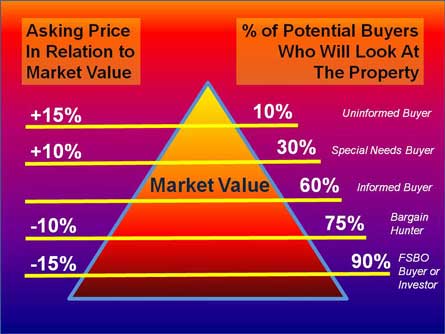Suddenly, Bob turned his eyes away from Carol and focused again on Broker Al.
‘Ok,’ he said, ‘You win. Price it at $300,000.’
Al felt all of the hope draining out of him. He’d been fighting the price battle now for 30 minutes. He’d thoroughly educated the sellers about the market place and the importance of right pricing. He’d gotten them over the fear that they were losing too much from the drop in values (see Clinic 1), demonstrated the importance of coming out of the chute with a good price (see Clinic 2) and he’d shown them what happens to the pool of potential buyers when a property is overpriced (see Clinic 3). He felt his head drop between his shoulders.
Now, it’s your turn to dictate the next action. Read the alternatives below and chime in on what you believe would be the best course of action. Cast your vote by leaving a comment. In fact, you might even have an entirely different idea — in which case, you can express that in a comment as well.
Alternative A) Take a Tour
Suddenly, Al looked up.
‘Tell you what,’ he began, ‘Let’s take a little field trip.’ Bob and Carol gave him an odd look. ‘Really,’ he continued, ‘Let’s take a short drive. I want you to see a couple of the homes potential buyers will be comparing yours to if you price at $300,000.’
After a brief moment of hemming and hawing, Bob and Carol agreed. As they walked out to the driveway, Al quickly went to work. Because he spent a little time every week previewing property, he knew he wanted to take them to a new development a couple of miles away with pricing from the low $300,000’s. But he also wanted them to see the split level on Ellis Ct. that just came on the market. At $304,900, it had four bedrooms — compared to Bob and Carol’s three — and a partial finished basement. As they started down the block, he made a quick call to set up the sudden showing.
35 minutes later, when they pulled back to the curb in front of Bob and Carol’s house, Al kept the car running. He wanted them to sit with him for a few moments and look at their house with their new Buyers’ Eyes.
‘Ok,’ said Al, ‘You’re a home buyer. You just came from seeing the split on Ellis and the models at Evening Star. I’m your agent and I’ve just brought you to this lovely little ranch with a carport. What do you think? ‘
Alternative B) Present an Example
Suddenly Al looked up.
‘I’m sorry,’ he said, ‘I just can’t do that.’
‘Why not?’ said Carol, surprised.
‘It’s not in your best interest,’ he replied. ‘Let me tell you about the two houses on Elm St. that came on the market earlier this year. It’s a cookie cutter subdivision, so these two houses were pretty similar — they were about the same size, same age and so on. I had one of them listed at market value: $184,900; the other was listed by another company and it was high: $199,900. I had an accepted offer at $184,000 within 30 days and it closed six weeks later. By that time the other house had been reduced twice, first to $194,900 and then to $189,900. Another month went by and the price was reduced again, this time to $185,900. Finally, almost five months after the sign went up, the sellers accepted an offer at $179,900. They played around with price and all it did was cost them time and, in the end, money. I don’t want to see that happen to you.’
Alternative C) Al Succumbs . . . Sort Of
Suddenly Al looked up.
‘Ok,’ he said, ‘but let’s make it $299,900 so it will still appear in searches up to $300. And I want to be clear that, while I’m willing to take the listing at that price and I will work on it just as hard as I do all of my listings, I believe we’re about $15,000 too high. I want us to agree now that we’ll revisit pricing if we don’t have a solid offer in 30 days. Fair enough?’
Alternative D) Happy Ending?
Suddenly Al looked up.
‘You know, Bob, Carol . . . I’d rather turn you down than let you down . . . and letting you down is exactly what I’d be doing if I took your listing at that price. My job is to get your property sold for the highest possible price and net dollars to you, and save you as much money as I can. I can’t do that if we come out of the chute with an unmarketable price.’ Al began to collect the papers littering the table before him, straightened them and put them back in the clipboard. Bob’s mouth had fallen open and Carol had a look of panic in her eyes. Now standing, Al extended his hand to Bob. ‘Thank you for taking time to meet with me tonight and if it doesn’t work out for you at $300,000, I’d be happy to meet with you again.’
Al smiled, turned and started to walk toward the front door . . .

